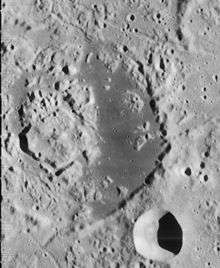Gerard (crater)
|
Lunar Orbiter 4 image centered on Gerard. Gerard A is the smaller crater at left. | |
| Coordinates | 44°30′N 80°00′W / 44.5°N 80.0°WCoordinates: 44°30′N 80°00′W / 44.5°N 80.0°W |
|---|---|
| Diameter | 98.78 km |
| Depth | 2.2 km |
| Colongitude | 82° at sunrise |
| Eponym | Alexander Gerard |
Gerard is a lunar crater that lies along the western edge of the Oceanus Procellarum near the northwest limb of the Moon's near side. It is located to the north-northwest of the crater von Braun, and northeast of Bunsen. Because of its location, Gerard appears strongly foreshortened when viewed from the Earth, hindering observation.
This is a worn and eroded formation with a rim that has been nearly obliterated in some locations and distorted in others. The northern half of the rim has outward bulges to the northeast, north, and northwest. The interior floor is rough in places, with several small and tiny craters along the floor and the eastern rim.
To the northwest of this formation is the unusual Gerard Q Inner (eastern floor covered in dark-hued basaltic lava) within the larger Gerard Q Outer, and a system of rilles named the Rimae Gerard. These extend for a distance of about 100 kilometers.
Satellite craters

By convention these features are identified on lunar maps by placing the letter on the side of the crater midpoint that is closest to Gerard.
| Gerard | Latitude | Longitude | Diameter |
|---|---|---|---|
| A | 45.1° N | 82.3° W | 17.31 km |
| B | 46.4° N | 88.3° W | 14.04 km |
| C | 45.9° N | 79.2° W | 29.36 km |
| D | 46.2° N | 79.9° W | 5.93 km |
| E | 44.5° N | 81.0° W | 5.28 km |
| F | 43.8° N | 82.3° W | 5.39 km |
| G | 45.7° N | 88.3° W | 26.9 km |
| H | 44.5° N | 87.0° W | 12.25 km |
| J | 46.9° N | 88.7° W | 9.35 km |
| K | 44.0° N | 77.2° W | 5.85 km |
| L | 43.2° N | 76.4° W | 4.5 km |
| Q Inner | 46.54° N | 83.13° W | 67.32 km |
| Q Outer | 46.51° N | 84.55° W | 192.48 km |
References
- Andersson, L. E.; Whitaker, E. A. (1982). NASA Catalogue of Lunar Nomenclature. NASA RP-1097.
- Blue, Jennifer (July 25, 2007). "Gazetteer of Planetary Nomenclature". USGS. Retrieved 2007-08-05.
- Bussey, B.; Spudis, P. (2004). The Clementine Atlas of the Moon. New York: Cambridge University Press. ISBN 978-0-521-81528-4.
- Cocks, Elijah E.; Cocks, Josiah C. (1995). Who's Who on the Moon: A Biographical Dictionary of Lunar Nomenclature. Tudor Publishers. ISBN 978-0-936389-27-1.
- McDowell, Jonathan (July 15, 2007). "Lunar Nomenclature". Jonathan's Space Report. Retrieved 2007-10-24.
- Menzel, D. H.; Minnaert, M.; Levin, B.; Dollfus, A.; Bell, B. (1971). "Report on Lunar Nomenclature by the Working Group of Commission 17 of the IAU". Space Science Reviews. 12 (2): 136–186. Bibcode:1971SSRv...12..136M. doi:10.1007/BF00171763.
- Moore, Patrick (2001). On the Moon. Sterling Publishing Co. ISBN 978-0-304-35469-6.
- Price, Fred W. (1988). The Moon Observer's Handbook. Cambridge University Press. ISBN 978-0-521-33500-3.
- Rükl, Antonín (1990). Atlas of the Moon. Kalmbach Books. ISBN 978-0-913135-17-4.
- Webb, Rev. T. W. (1962). Celestial Objects for Common Telescopes (6th revised ed.). Dover. ISBN 978-0-486-20917-3.
- Whitaker, Ewen A. (1999). Mapping and Naming the Moon. Cambridge University Press. ISBN 978-0-521-62248-6.
- Wlasuk, Peter T. (2000). Observing the Moon. Springer. ISBN 978-1-85233-193-1.
